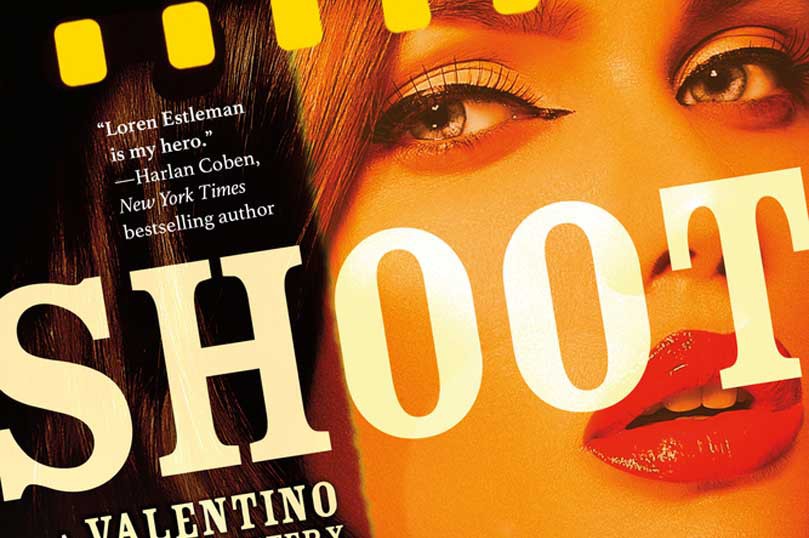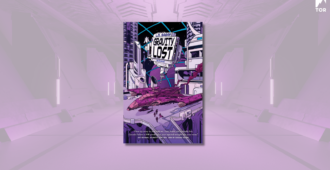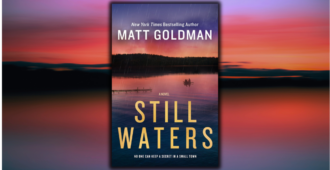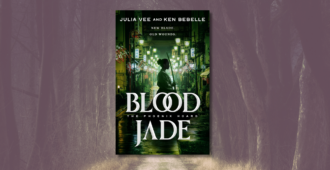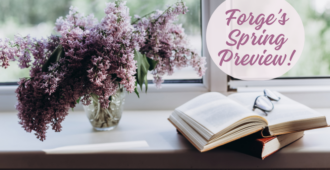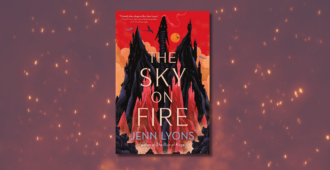 Shoot, the latest in Loren D. Estleman’s Valentino mysteries, follows Valentino, a mild-manner film archivist at UCLA and sometime film detective.
Shoot, the latest in Loren D. Estleman’s Valentino mysteries, follows Valentino, a mild-manner film archivist at UCLA and sometime film detective.
At the closing party for the Red Montana and Dixie Day museum, Valentino is approached by Red Montana, western film and television star. Red is being blackmailed over the existence of a blue film that his wife made early in her career, and offers Valentino a deal — find the movie, and he can have Red’s lost film, Sixgun Sonata, that Red has been hiding away in his archives.
As Valentino races to uncover the truth before time runs out, his heroes begin their fall from grace. Valentino desperately wants to save Sixgun Sonata…but at what cost? Please enjoy this excerpt of Shoot.
1
“THIS IS CUTE.” Harriet Johansen touched a sample.
“Cute isn’t what we’re going for,” Valentino said.
She smiled, a bit stiffly. “Pardon me, maestro.”
They were seated beside Leo Kalishnikov, Valentino’s architect and designer, at a large table in a studio in Tarzana—the only city in the U.S. named after a fictional character—browsing through a heavy volume the size of a family photo album. The studio was on the third floor of a faux-Spanish modern house with stucco walls and enormous Plexiglas windows overlooking the residential sprawl, with natural light flooding in; a shoreward-bound wind had exiled the smog into the desert east of L.A., where presumably it shriveled away in the Mojave heat.
The house was so well-proportioned that from a distance it looked no larger than the average McMansion, but it covered a city block.
“It’s an exact copy of Harold Lloyd’s estate in Beverly Hills,” said their hostess, a tall woman hovering around fifty in black leotards and tights with her hair cut short and dyed glossy Florsheim-black. Valentino thought she looked like a retired ballerina from some Eastern Bloc country; the fact that she spoke with no accent at all confirmed her foreignness.
It was a bright, airy space, a thousand square feet of terra-cotta tiles, eggshell-colored paneling, lighting both indirect and direct, original architects’ drawings in copper frames on the walls, and bolts of material lined up in racks like torpedoes waiting to be loaded.
But in place of pages of photographs, the huge book contained carpet samples. The one Harriet had pointed out was a brightly colored image of film reels uncoiling serpentine strips of celluloid in yellow on a burgundy background.
“Indeed,” said Kalishnikov. “We’re designing a classic motion-picture palace, not a home theater for the basement of a used-car baron in the Valley.”
Harriet looked at him. She was uncommonly pretty in casual dress, a fitted shirt with the tail out over Capri pants and the cuffs turned back, her ash-blond hair in a ponytail tied with a blue bandanna. “Isn’t that what you do when you’re not designing motion-picture palaces?”
He said nothing. He wore his favorite working uniform of silk-lined opera cape over a cutaway coat. His broad-brimmed gaucho hat lay on a corner of the table. Shiny patches of grafted skin pulled his seventy-year-old eyes into an Asian tilt. So far he’d neither spoken to Harriet nor even looked her way. Plainly he resented an outsider’s intrusion into the appointment.
Valentino, hoping to defuse the tension, asked their hostess standing on the other side of the table how many more books she had in stock.
“Let’s see.” She glanced at the stack of books they’d discarded. “You’ve been through sixteen. There are twenty-four left.”
“I meant of theater carpet.”
“Yes, I know.”
He groaned inwardly. The whole thing was uncomfortably like evaluating samples of wedding invitations, an ordeal he’d been unaware of until a close friend who was going through that actual process had related it to him in excruciating detail. He loved Harriet, but he wasn’t ready for that plunge. The years he’d already invested in restoring The Oracle to its Prohibition-era glory was challenge enough for now.
He turned to the architect. “What about that one with the Greek letters?”
“You mean the Arabesque.” Kalishnikov, who seemed to have a photographic memory for which sample was in which book, off-loaded four volumes from the towering stack of deadwood, dragged over one bound in aubergine vinyl, and opened it directly to the sample. The squarish design, resembling hieroglyphics, was a border in muted gold on a midnight-blue background; the fibers were stiff, made of some synthetic material that resembled wool but were guaranteed to withstand ten years of heavy foot-traffic. From an inside breast pocket he drew a flat wallet, the kind made to contain square foreign currency, and slid out a photograph. It was black-and-white, a digital copy of an old snapshot taken of The Oracle sometime during the Great Depression. “Drapes, please, Sila. It will never be seen under natural illumination.”
The woman nodded and touched something under the table. Blackout curtains glided noiselessly across the windows, suspended from a hidden track.
“Dimmers, please. I’ll tell you when it’s right.”
She touched something else. Slowly the light in the room softened. This went on until Valentino could barely make out his companions’ faces.
“Spasibo.”
Sila immediately halted the dimming process; which settled the question of her origins, so far as he was concerned. Kalishnikov had fled Belarus shortly after the USSR fell.
For a time he studied the sample as it would appear in a room lit only by wall sconces and stumble-bulbs on aisle risers.
“We can’t be sure about the colors, of course,” he said, “but the pattern is similar.”
Valentino and Harriet watched him closely, their heads almost touching, her hand gripping his under the table, tightly enough to compress his knuckles. He felt a ghost of a promise of the dawn of hope.
Kalishnikov shook his head. Hope flickered, died.
He closed the book, returned the photo to the wallet, the wallet to the pocket, and the book to the stack. “Similar is not the same.”
The film archivist winced; Harriet was a CSI with the L.A.P.D., and years of working with forceps and rib-spreaders had given her the grip of the daring young woman on the flying trapeze. “At exactly what point did I lose control of this project I’m paying for?” he asked Kalishnikov.
“When you signed the contract. You agreed to respect my decisions. ‘I want this done right, or not at all.’ Your exact words when you called me; I remind you I was in Venice at the time, installing a screening room for a film director with the government arts program in Rome. I equate ‘right’ with ‘authentic,’ yes?”
He acknowledged defeat with a nod. When Kalishnikov slipped into an immigrant’s use of English, the battle was over. Harriet, sensitive as always to Valentino’s every mood, relaxed her grasp and patted his hand.
The architect drew a platinum watch from a vest pocket and popped open the lid. A tiny hidden music box played “Lara’s Theme” from Doctor Zhivago. “We’ll have to continue this at another time. I have to meet with a member of the Department of the Interior.”
“Whatever for?” Harriet asked.
“A shipment of mahogany has come in from Central America, and I must show papers to prove that it did not come from the Brazilian rainforest. Things were so much simpler when the aristocrats were allowed to rape the earth without interference.” He stood, bowed to the woman who owned the decorating firm, then to Harriet, acknowledging her existence for the first time. “I bid you all good day.” He groped his way out.
The lights came up, the curtains slid back into their invisible wall pockets: Intermission. Everything in Southern California seemed to have been built on the picture-palace standard.
Valentino watched the woman returning the books they’d been through to a tall shelf. He hoped she had a system of determining which ones they’d seen. The prospect of going back to scratch made Sisyphus’ job look part-time.
But he was grateful for the break. They’d spent four hours staring at carpet samples. His neck was stiff, his eyes stung, his head spun with colors and patterns like a kaleidoscope gone rogue, and he still couldn’t tell taupe from beige or burgundy from claret or sea- from foam-green or charcoal from chalk from iron from ash from gunmetal from—fifty shades of gray, my—
Harriet checked the time on her smartphone. “Just as well. We should get ready for the reception.”
They’d descended the stairs to the foyer, whose walls were shingled with framed autographed photos of celebrity customers in glass frames. Just looking at them made him think of flocks of dollar bills sprouting wings and flying out the window. A pale female creature as sleek as the décor sat behind a glass desk. Everything on the ground floor appeared to be made of glass; even her legs looked like stemware. She didn’t look up from her copy of Elle as they walked past.
“What reception?”
“Don’t act ignorant. You know the one.”
“I thought that was next week.”
“No, you didn’t. You see the invitation every day. I taped it to your bathroom mirror so you wouldn’t forget.”
“Can’t we give it a pass? Trust me, nobody will notice.”
“I thought you were a fan.”
“I am; but you know how these affairs go. The room will be so crowded we won’t be able to see anything, and we’ll be lucky to have thirty seconds with the host. Anyway, it’s sad. He’s shutting down the museum because no one’s interested in his kind of western anymore.”
She patted his hand and smiled. “You’re not no one, Val. I happen to know you passed up an offer for your original Red Montana cap pistols that would have paid for twenty square feet of carpet for that old barn of yours.”
“Not just the pistols,” he said. “The guy wanted the holster, too; also the hat, vest, chaps, and boots. They’d have paid for the rest. But now the bottom will drop out of the market because every collector in the country will be after the originals. They’ve never been for sale before.”
“You could have sold yours at any time.”
“So I’m stupid. So what?”
“So you’re both the last of your breed, you and Red. Trust me, he’ll give you more than thirty seconds.”
Which was truer than even Harriet predicted.
Copyright © 2016 by Loren D. Estleman
Shoot releases February 9. Pre-order it today: Amazon | Barnes & Noble | Books-a-Million | Indiebound | Powell’s

